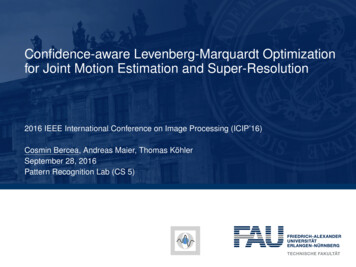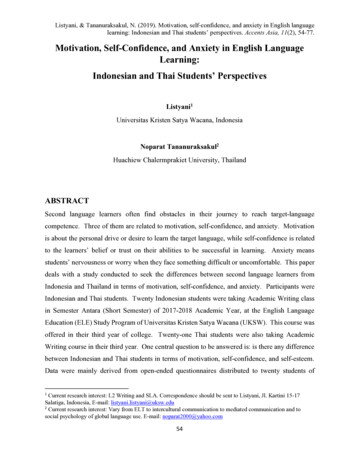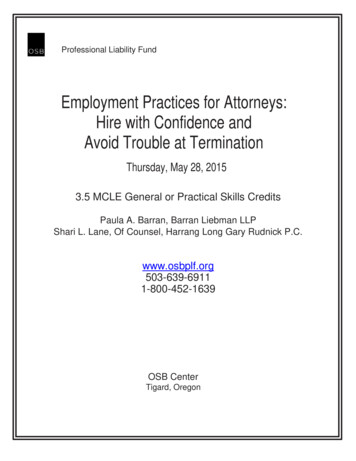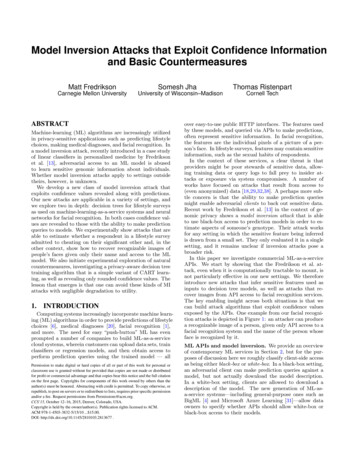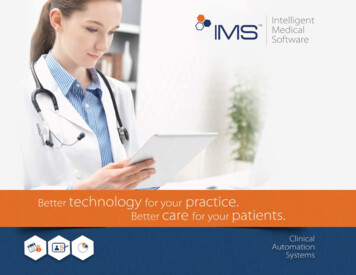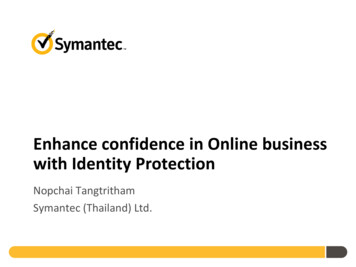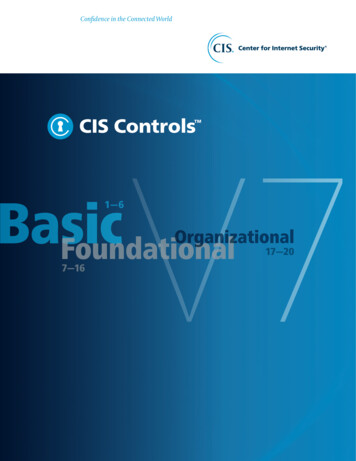
Transcription
Confidence in the Connected WorldCIS Controls BasicFoundational1—6Organizational7—1617—20
March 19, 2018This work is licensed under a Creative Commons Attribution-Non Commercial-No Derivatives 4.0International Public License (the link can be found at egalcode).To further clarify the Creative Commons license related to the CIS Controls content, you areauthorized to copy and redistribute the content as a framework for use by you, within yourorganization and outside of your organization for non-commercial purposes only, provided that(i) appropriate credit is given to CIS, and (ii) a link to the license is provided. Additionally, if youremix, transform or build upon the CIS Controls, you may not distribute the modified materials.Users of the CIS Controls framework are also required to refer to (http://www.cisecurity.org/controls/) when referring to the CIS Controls in order to ensure that users are employing the mostup-to-date guidance. Commercial use of the CIS Controls is subject to the prior approval of CIS (Center for Internet Security, Inc.).AcknowledgmentsCIS (Center for Internet Security, Inc.) would like to thank the many securityexperts who volunteer their time and talent to support the CIS Controls and other CIS work. CIS products represent the effort of a veritable army ofvolunteers from across the industry, generously giving their time and talentin the name of a more secure online experience for everyone.
Contents1 Introduction2 Why the CIS Controls Work:Methodology and Contributors3 How to Get Started3 This Version of the CIS Controls4 Other Resources4 Structure of theCIS Controls Document5 CIS Controls 1 – 2055 Closing Notes
BasicFoundationalOrganizational1Inventory and Controlof Hardware Assets7Email and WebBrowser Protections17Implement a SecurityAwareness and TrainingProgram2Inventory and Controlof Software Assets8Malware Defenses18Application 9Limitation and Controlof Network Ports,Protocols, and Services19Incident Responseand Management4Controlled Useof AdministrativePrivileges10Data RecoveryCapabilities20Penetration Tests andRed Team Exercises5Secure Configuration forHardware and Software onMobile Devices, Laptops,Workstations and Servers11Secure Configurationfor Network Devices,such as Firewalls,Routers and Switches6Maintenance,Monitoring andAnalysis of AuditLogs12Boundary Defense13Data Protection14Controlled AccessBased on the Needto Know15Wireless AccessControl16Account Monitoringand Control
V7IntroductionThe CIS Controls are a prioritized set of actions that collectively form a defense-in-depth setof best practices that mitigate the most common attacks against systems and networks. TheCIS Controls are developed by a community of IT experts who apply their first-hand experienceas cyber defenders to create these globally accepted security best practices. The experts whodevelop the CIS Controls come from a wide range of sectors including retail, manufacturing,healthcare, education, government, defense, and others.We are at a fascinating point in the evolution of what we now call cyber defense. Massive datalosses, theft of intellectual property, credit card breaches, identity theft, threats to our privacy,denial of service – these have become a way of life for all of us in cyberspace.And, as defenders we have access to an extraordinary array of security tools and technology,security standards, training and classes, certifications, vulnerability databases, guidance, bestpractices, catalogs of security controls, and countless security checklists, benchmarks, andrecommendations. To help us understand the threat, we’ve seen the emergence of threatinformation feeds, reports, tools, alert services, standards, and threat sharing frameworks. To topit all off, we are surrounded by security requirements, risk management frameworks, complianceregimes, regulatory mandates, and so forth. There is no shortage of information available tosecurity practitioners on what they should do to secure their infrastructure.But all of this technology, information, and oversight has become a veritable “Fog of More” –competing options, priorities, opinions, and claims that can paralyze or distract an enterprisefrom vital action. Business complexity is growing, dependencies are expanding, users arebecoming more mobile, and the threats are evolving. New technology brings us great benefits,but it also means that our data and applications are now distributed across multiple locations,many of which are not within our organization’s infrastructure. In this complex, interconnectedworld, no enterprise can think of its security as a standalone problem.So how can we as a community – the community-at-large, as well as within industries, sectors,partnerships, and coalitions – band together to establish priority of action, support each other,and keep our knowledge and technology current in the face of a rapidly evolving problem andan apparently infinite number of possible solutions? What are the most critical areas we needto address and how should an enterprise take the first step to mature their risk managementprogram? Rather than chase every new exceptional threat and neglect the fundamentals, howcan we get on track with a roadmap of fundamentals, and guidance to measure and improve?Which defensive steps have the greatest value?These are the kinds of issues that led to and now drive the CIS Controls. They started as a grassroots activity to cut through the “Fog of More” and focus on the most fundamental and valuableactions that every enterprise should take. And value here is determined by knowledge and data –the ability to prevent, alert, and respond to the attacks that are plaguing enterprises today.Led by CIS, the CIS Controls have been matured by an international community of individuals andinstitutions that: share insight into attacks and attackers, identify root causes, andtranslate that into classes of defensive action; document stories of adoption and share tools to solve problems; track the evolution of threats, the capabilities of adversaries, andcurrent vectors of intrusions; map the CIS Controls to regulatory and compliance frameworks andbring collective priority and focus to them; share tools, working aids, and translations; and identify common problems (like initial assessment andimplementation roadmaps) and solve them as a community.1
2These activities ensure that the CIS Controls are not just another list of good things to do, buta prioritized, highly focused set of actions that have a community support network to makethem implementable, usable, scalable, and compliant with all industry or government securityrequirements.Why the CIS Controls Work: Methodology and ContributorsThe CIS Controls are informed by actual attacks and effective defenses and reflect the combinedknowledge of experts from every part of the ecosystem (companies, governments, individuals);with every role (threat responders and analysts, technologists, vulnerability-finders, tool makers,solution providers, defenders, users, policy-makers, auditors, etc.); andwithin many sectors (government, power, defense, finance, transportation,academia, consulting, security, IT) who have banded together to create,The Center for Internet Security, Inc.adopt, and support the Controls. Top experts from organizations pooled(CIS) is a 501c3 non-profit organizationtheir extensive first-hand knowledge from defending against actualwhose mission is to identify, develop,cyber-attacks to evolve the consensus list of Controls, representing thevalidate, promote, and sustain bestbest defensive techniques to prevent or track them. This ensures that thepractices in cybersecurity; deliverCIS Controls are the most effective and specific set of technical measuresavailable to detect, prevent, respond, and mitigate damage from the mostworld-class cybersecurity solutionscommon to the most advanced of those attacks.to prevent and rapidly respond tocyber incidents; and build and leadcommunities to enable anenvironment of trust in cyberspace.For additional information, go tohttps://www.cisecurity.org/The CIS Controls are not limited to blocking the initial compromise ofsystems, but also address detecting already-compromised machinesand preventing or disrupting attackers’ follow-on actions. The defensesidentified through these Controls deal with reducing the initial attacksurface by hardening device configurations, identifying compromisedmachines to address long-term threats inside an organization’s network,disrupting attackers’ command-and-control of implanted malicious code,and establishing an adaptive, continuous defense and response capabilitythat can be maintained and improved.The five critical tenets of an effective cyber defense system as reflected inthe CIS Controls are:Offense informs defense: Use knowledge of actual attacks that havecompromised systems to provide the foundation to continually learnfrom these events to build effective, practical defenses. Include only thoseControls that can be shown to stop known real-world attacks.Prioritization: Invest first in Controls that will provide the greatest riskreduction and protection against the most dangerous threat actors andthat can be feasibly implemented in your computing environment.Measurements and Metrics: Establish common metrics to provide a sharedlanguage for executives, IT specialists, auditors, and security officials tomeasure the effectiveness of security measures within an organization sothat required adjustments can be identified and implemented quickly.Continuous diagnostics and mitigation: Carry out continuousmeasurement to test and validate the effectiveness of current securitymeasures and to help drive the priority of next steps.Automation: Automate defenses so that organizations can achieve reliable,scalable, and continuous measurements of their adherence to the Controlsand related metrics.
V7How to Get StartedThe CIS Controls are a relatively small number of prioritized, well-vetted, and supported securityactions that organizations can take to assess and improve their current security state. They alsochange the discussion from “what should my enterprise do” to “what should we ALL be doing” toimprove security across a broad scale.But this is not a one-size-fits-all solution, in either content or priority. You must still understandwhat is critical to your business, data, systems, networks, and infrastructures, and you mustconsider the adversarial actions that could impact your ability to be successful in the business oroperation. Even a relatively small number of Controls cannot be executed all at once, so you willneed to develop a plan for assessment, implementation, and process management.CIS Controls 1 through 6 are essential to success and should be considered among the very firstthings to be done. We refer to these as “Cyber Hygiene” – the basic things that you must do tocreate a strong foundation for your defense. This is the approach taken by, for example, the DHSContinuous Diagnostic and Mitigation (CDM) Program, one of the partners in the CIS Controls.A similar approach is recommended by our partners in the Australian Signals Directorate (ASD)with their “Essential Eight” – a well-regarded and demonstrably effective set of cyber defenseactions that map very closely into the CIS Controls. This also closely corresponds to the messageof the US-CERT (Computer Emergency Readiness Team).This Version of the CIS ControlsWith the release of Version 6 of the CIS Controls (in October 2015), we put in place the means tobetter understand the needs of adopters, gather ongoing feedback, and understand how thesecurity industry supports the CIS Controls. We used this to drive the evolution of Version 7, bothin this document and in a complementary set of products from CIS.In addition to the critical tenets of cyber defense mentioned previously, we also tried to ensurethat every CIS Control is clear, concise, and current. While there’s no magic bullet when definingsecurity controls, we think this version sets the foundation for much more straightforward andmanageable implementation, measurement, and automation.At CIS, we listen carefully to all of your feedback and ideas for the CIS Controls. In particular,many of you have asked for more help with prioritizing and phasing in the CIS Controls for yourcybersecurity program. This topic deserves more thought than we had time for in this Version 7update, so we’ve decided to address it separately in the near future. We’ll soon be surveying CISControls adopters to better understand your needs in this area. You can also help out by sendingus your feedback and ideas on prioritization now (controlsinfo@cisecurity.org), or by joining theCIS WorkBench Community We also provide detailed change information to minimize the work for enterprises that choose tomigrate from Version 6 to Version 7.3
4Other ResourcesThe true power of the CIS Controls is not about creating the best list of things to do, it’s aboutharnessing the experience of a community of individuals and enterprises to make securityimprovements through the sharing of ideas, and collective action.To support this, CIS acts as a catalyst and clearinghouse to help us all learn from each other. SinceVersion 6, there has been an explosion of complementary information, products, and servicesavailable from CIS, and from the industry at large. Please contact CIS for the following kinds ofworking aids and other support materials: Mappings from the Controls to a very wide variety of formal RiskManagement Frameworks (like FISMA, ISO, etc.) Use Cases of enterprise adoption Measurement and Metrics for the CIS Controls Version 7 Information tailored for Small and Medium Enterprises Pointers to vendor white papers and other materials that supportthe Controls Document
losses, theft of intellectual property, credit card breaches, identity theft, threats to our privacy, denial of service – these have become a way of life for all of us in cyberspace. And, as defenders we have access to an extraordinary array of security tools and technology, security standards, training and classes, certifications, vulnerability databases, guidance, best practices, catalogs

